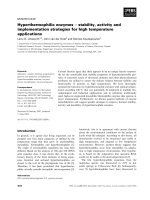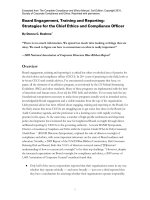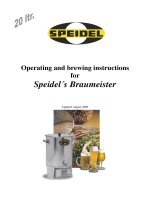Mesoporous carbon silica encapsulated molybdenum and ruthenium nanocatalysts for green chemistry applications
Bạn đang xem bản rút gọn của tài liệu. Xem và tải ngay bản đầy đủ của tài liệu tại đây (19.65 MB, 236 trang )
MESOPOROUS CARBON/SILICA ENCAPSULATED
MOLYBDENUM AND RUTHENIUM NANOCATALYSTS
FOR GREEN CHEMISTRY APPLICATIONS
DOU JIAN
NATIONAL UNIVERSITY OF SINGAPORE
2013
MESOPOROUS CARBON/SILICA ENCAPSULATED
MOLYBDENUM AND RUTHENIUM NANOCATALYSTS
FOR GREEN CHEMISTRY APPLICATIONS
DOU JIAN
(M. ENG., NUS)
A THESIS SUBMITTED
FOR THE DEGREE OF DOCTOR OF PHILOSOPHY
DEPARTMENT OF CHEMICAL AND BIOMOLECULAR
ENGINEERING
NATIONAL UNIVERSITY OF SINGAPORE
2013
DECLARATION
I hereby declare that the thesis is my original work and it
has been written by me in its entirety.
I have duly acknowledged all the sources of information
which have been used in the thesis.
This thesis has also not been submitted for any degree in any
university previously.
Dou Jian
12 August 2013
i
Acknowledgements
The journey to accomplishment of my PhD degree has been one of the most important
steps in my life. It would not have been possible without the help, support, and
encouragement of the following people.
First and foremost, I would like to express my sincere appreciation to my advisor,
Prof Zeng Hua Chun, for his generous support of my research in his group. Through
all the one-to-one discussions with him, he brought me into the world of nanocatalyst
research. He always inspires me with his broad knowledge and precious insights. His
integrity and dedication in research has been of great value for me. The knowledge,
experience and confidence gained from working with him will benefit me for all my
life.
I would also like to thank my group members for many helps and fruitful discussions.
Dr. Xiong Sheng Lin and Dr. Li Cheng Chao have many research experiences and
have taught me a lot. Special thanks to Dr. Xi Bao Juan for teaching me draw crystal
structures and Mr. Sheng Yuan for setting up the gas reactor. I have learnt many tips
of TEM operation from Dr. Zhang Yu Xing, Dr. Wang Dan Ping, Mr. Yec
Christopher Cheung and Ms Liu Min Hui. I shall also thank Dr. Zhang Sheng Mao,
Dr. Yao Ke Xin, Dr. Pang Mao Lin, Dr. Li Xuan Qi, Mr. Li Zheng, Ms. Wentalia
Widjajanti, Ms. Chng Tin Tin, Mr. Zhan Guo Wu and Ms Zhou Yao for helping me in
this or other ways.
ii
I would like to extend my gratitude to Ms Sandy Khoh and Ms Li Feng Mei for their
laboratory technical support. Ms. Yasotha Kathiraser from Prof Kawi’s group has
helped me with TPD analysis. I shall thank Mr. Chia Phai Ann and Mr. Mao Ning for
assisting in TEM analysis, Mr. Morgan and Mr. Liu Zhi Cheng for help with SEM
and XRD analysis, and Dr. Yuan Ze Liang for XPS analysis. Sincere thanks also
extend to Mr. Bin Dolmanan Surani from institute of materials research and
engineering (IMRE) for Raman characterization and Ms. Han Yan Hui from
Chemistry Department for NMR analysis. I shall also acknowledge the research
scholarship from Chemical and Biomolecular Engineering, NUS.
Finally, I would like to thank my family members for their enormous support and love
all the way. They make this accomplishment more meaningful.
iii
Table of Contents
Acknowledgements i
Table of Contents iii
Summary…………………………………………………………………………….viii
Symbols and Abbreviations x
List of Tables……………………………………………………………………… xiii
List of Figures……………………………………………………………………….xiv
Publications Related to the Thesis xxiv
Chapter 1 Introduction 1
1.1 Overview………………………………………………………………………… 1
1.2 Objectives and Scope 3
1.3 Organization of the Thesis 4
1.4 References. 7
Chapter 2 Literature Review 8
2.1 Overview of Nanocatalysts 8
2.2 Molybdenum Oxides and Ruthenium Based Nanocomposit Catalysts 17
2.2.1 Molybdenum Oxides 18
2.2.1.1 Molybdenum trioxide and molybdenum dioxide 18
iv
2.2.1.2 Molybdenum based heteropoly acids 21
2.2.2 Ruthenium Nanoparticles 23
2.2.3 Integrated Nanocatalysts 25
2.3 Green Chemistry 30
2.3.1 Friedel-Crafts Alkylation 30
2.3.2 Oxidative Desulfurization 33
2.2.3 CO
2
Hydrogenation 36
2.5 References ……………………………………………………………………… 41
Chapter 3 Characterization Methods……………………………………………… 49
3.1 Powder X-ray Diffraction (XRD) and Small-angle X-ray Diffraction (SAXRD)….
49
3.2 Field Emission Scanning Electron Microscopy (FESEM) and Energy Dispersive
X-ray Spectroscopy (EDX) 50
3.3 Transmission Electron Microscopy (TEM) 50
3.4 Nitrogen Adsorption-Desorption Analysis 51
3.5 X-ray Photoelectron Spectroscopy (XPS) 52
3.6 Thermogravimetric Analysis (TGA) 52
3.7 Fourier Transform Infrared Spectroscopy (FTIR) 53
3.8 Gas Chromatography (GC) and Mass Spectroscopy (MS) 53
3.9 References… 55
v
Chapter 4 Preparation of Mo-Embedded Mesoporous Carbon Microspheres for
Friedel-Crafts Alkylation 56
4.1 Introduction 56
4.2 Experimental Section 59
4.2.1 Materials Preparation 59
4.2.2 Materials Characterization 60
4.2.3 Benzylation of Toluene 61
4.3 Results and Discussion 62
4.4 Conclusions 81
4.5 References. 83
Chapter 5 Targeted Synthesis of Silicomolybdic Acid (Keggin acid) inside
Mesoporous Silica Hollow Spheres for Friedel-Crafts Alkylation 86
5.1 Introduction 86
5.2 Experimental Section 91
5.2.1 Preparation of MoO
2
Nanoparticles. 91
5.2.2 Preparation of MoO
2
@SiO
2
Core-Shell Spheres 92
5.2.3 Preparation of Mo
VI
@mSiO
2
Hollow Spheres. 93
5.2.4 Preparation of H
4
SiMo
12
O
40
@mSiO
2
Hollow Spheres. 93
5.2.5 Friedel-Crafts Benzylation of Toluene. 94
5.2.6 Materials Characterization. 95
5.3 Results and Discussion 96
vi
5.4 Conclusions 127
5.5 References. 129
Chapter 6 Integrated Catalyst-Adsorbent of Mo/SiO
2
Nanowires with Highly
Accessible Mesopores for Oxidative Desulfurization of Model
Diesel………… 134
6.1 Introduction 134
6.2 Experimental Section 139
6.2.1 Preparation of Mesoporous Silica (mSiO
2
) Nanowire-Networks 139
6.2.2 Preparation of Mo/mSiO
2
Network Catalysts 139
6.2.3 Oxidative Desulfurization (ODS) of Model Diesel 140
6.2.4 Regeneration of Mo/mSiO
2
Catalyst-Adsorbent 140
6.2.5 Materials Characterization 141
6.3 Results and Discussion 142
6.4 Conclusions 169
6.5 References ………………………………………………………………………171
Chapter 7 Mesoporous Silica Nanowires Encapsulated Ru Nanoparticles for Selective
Hydrogenation of CO
2
to CO 174
7.1 Introduction 174
7.2 Experimental Section 177
7.2.1 Preparation of Ruthenium Nanoparticles 177
7.2.2 Preparation of Ru@mSiO
2
Nanowires 177
7.2.3 Hydrogenation of CO
2
178
vii
7.2.4 Materials Characterization 179
7.3 Results and Discussion 180
7.4 Conclusions 199
7.5 References. 201
Chapter 8 Conclusions and Recommendations 204
8.1 Conclusions 204
8.2 Recommendations 207
8.3 Rererences ………………………………………………………………………209
viii
Summary
Nanocatalysts have received numerous research interests recently, owing to
advancement in material chemistry and nanotechnology. With well-defined size,
shape, composition and structure, nanocatalysts have huge potential to be used as
active and selective catalysts for a wide range of catalytic reactions. In addition,
encapsulation of nanocatalysts within mesoporous supports has benefits of easy
separation of used catalysts and enhancement of catalyst stability.
Goal of this project is to develop active, selective and stable nanocatalysts for green
chemistry applications. In this thesis, molybdenum oxide and ruthenium nanoparticles
were selected as model metal oxide and metal compounds to be encapsulated within
mesoporous carbon and silica supports. The resulted nanocatalysts have been tested
for Friedel-Crafts alkylation, oxidative desulfurization, and carbon dioxide
hydrogenation reactions.
Mo@C catalysts were firstly synthesized by hydrothermal method. Under
hydrothermal condition, glucose molecules polymerized to form carbonaceous
spheres via intramolecular dehydration reaction. Simultaneously, ammonium
heptamolybdate was reduced by glucose to generate molybdenum dioxide
nanoparticles, which was encapsulated by in-situ formed carbonaceous spheres. The
resulted Mo@C materials were further thermally treated to generate meso- and micro-
porosity. It was observed that oxidized MoO
3
@C was an effective solid acid catalyst
for Friedel-Crafts alkylation reaction.
ix
Other than carbon, mesoporous silica was also used as catalyst support for
molybdenum oxide nanoparticles. The pre-synthesized MoO
2
nanoparticles were
encapsulated by mesoporous silica shell to generate core-shell structure. After thermal
treatment, the encapsulated MoO
2
nanoparticles was oxidized to Mo
6+
and infused
into silica shell. The resulted Mo
VI
@mSiO
2
was hydrated to generate strong solid acid
(e.g., H
4
SiMo
12
O
40
) within porous silica shell. The fabricated H
4
SiMo
12
O
40
@mSiO
2
hollow spheres exhibited excellent activity for benzylation of toluene. In addition, the
H
4
SiMo
12
O
40
@mSiO
2
was very robust and could be reused after regeneration.
Integration of nanostructured mesoporous silica and related functional materials into
larger assemblages will benefit their applications as heterogeneous catalyst, due to
easy separation from reaction mixture. Toward this direction, mesoporous silica
nanowires were synthesized via an emulsion templated method. Through thermal
treatment, the silica nanowires aggregated together to form a network structure having
hierarchical mesopores. The networked silica nanowires have been used to support
molybdenum oxide, and the resulted network catalyst was an effective catalyst-
adsorbent for removing sulfur from model diesel via oxidative desulfurization route.
Confinement of nanoparticles within porous structure has been established as an
effective strategy to prepare stable nanocatalysts for catalytic reactions. Herein, we
demonstrated that selective nanocatalysts for hydrogenation of carbon dioxide to
carbon monoxide can be developed by encapsulation of ruthenium nanoparticles
within mesoporous silica network structure. As a comparison, larger ruthenium
nanoparticles outside mesopores were responsible for hydrogenation of carbon
dioxide to methane.
x
Symbols and Abbreviations
Symbols
S
BET
Specific surface area
ppm
Parts per million
CO
ad
Adsorbed surface carbonyl
O
ad
Adsorbed surface oxygen
C
ad
Adsorbed surface carbon
H
ad
Adsorbed surface hydrogen
p
Pressure
p
0
Saturated pressure
S
BET
BET surface area
S
me
Mesorpore surface area
V
mi
Micropore volume
V
tot
Total pore volume
V
me
Mesopore volume
d
Average pore diameter
A@B
Core-shell structure, where A is core and B is shell.
λ
Wavelength of X-ray radiation
Å
Angstrom
Hν
Incident photon energy
a
0
, b
0
, c
0
Lattice constants
Mo
6+
, Mo
VI
Molybdenum in +6 oxidation state
mSiO
2
Mesoporous silica
xi
Abbreviations
XRD
X-ray diffraction
TEM
Transmission electron microscope
HRTEM
High resolution transmission electron microscope
FESEM
Field emission scanning electron microscope
EDX
Energy dispersive X-ray spectroscopy
XPS
X-ray photoelectron spectroscopy
LEED
Low energy electron diffraction
STM
Scanning tunneling microscopy
1, 2, 3D
1, 2, 3 Dimensional
HP-STM
High pressure scanning tunneling microscopy
AP-XPS
Ambient pressure X-ray photoelectron spectroscopy
PVP
Polyvinylpyrrolidone
ATR-IR
Attenuated total reflectance infrared spectroscopy
SBA
Santa Barbara amorphous type material
HDS
Hydrodesulfurization
ZSM-5
Zeolite socony mobile-5
MOF
Metal organic framework
UV
Ultraviolet
F-C
Friedel-Crafts
MCM-22
Mobile composite of matter
xii
TOF
Turn over frequency
ODS
Oxidative desulfurization
TGA
Thermogravimetric analysis
FTIR
Fourier transform infrared spectroscopy
GC
Gas chromatography
MS
Mass spectroscopy
TPD
Temperature programmed desorption
TCD
Thermal conductivity detector
JCPDS
Joint committee on powder diffraction standards
SAXRD
Small angle X-ray diffraction
BE
Binding energy
PMA
Phosphomolybdic acid
CTAB
Hexadecyltrimethylammonium bromide
CTACl
Hexadecyltrimethylammonium chloride
TEOS
Tetraethyl orthosilicate
EtOH
Ethanol
TEA
Triethanolamine
xiii
List of Tables
Table 2.1 Comparison of Friedel-Crafts Alkylation of Toluene over Solid Acid
Catalyst 32
Table 2.2 Comparison of oxidative desulfurization catalysts 35
Table 2.3 Comparison of reverse water gas shift reaction over various catalysts 38
Table 2.4 Comparison of methanation reaction over various catalysts 40
Table 4.1 Porosity parameters of encapsulated carbon spheres calculated from
nitrogen adsorption isotherms. S
BET
: BET surface area; S
me
: mesopore
surface area; V
mi
: micropore volume; V
tot
: total volume; V
me
: mesopore
volume; and d: average pore diameter………………………………….73
Table 4.2 Friedel-Crafts Alkylation of toluene over solid acid catalysts…………78
Table 5.1 Physical properties of the Mo
VI
@mSiO
2
-X (X = 10, 20, 30, and 40)
hollow spheres with different Mo contents……………………… 110
Table 5.2 Comparison of Friedel-Crafts alkylation of toluene over solid acid
catalysts 113
Table 6.1 Comparison of oxidative desulfurization of model diesel over supported
Molybdenum catalysts…………………………….……………………159
Table 7.1 Hydrogenation of CO
2
with Ru@mSiO
2
catalysts …….…….…….….192
xiv
List of Figures
Figure 2.1 The three types of model catalysts: (a) single crystal, (b) nanoparticles
encapsulated within 3D mesoporous silica, and (c) 2D assembly of
nanoparticles 10
Figure 2.2 Nanometer sized Pt oxide on a stepped Pt(557) single crystal surface
after exposing to 1 torr of O
2
at room temperature 10
Figure 2.3 Effect of gold particle size on the activity of CO oxidation 12
Figure 2.4 The influence of cobalt particle size on Fischer-Tropsch activity 12
Figure 2.5 Turnover rates and Arrhenius plots of cyclohexane and cyclohexene
formation on cubic and cuboctahedral Pt nanoparticles 13
Figure 2.6 TEM images of the as-prepared Ag and AuAg alloy nanoparticles 15
Figure 2.7 Rates of formic acid decomposition versus work function of
nanocatalysts. 16
Figure 2.8 a) ATR-IR of CO on polymer-stabilized colloid Pd. b) Calculated
electron density difference contour of CO after adsorption on Pd (111)
17
Figure 2.9 Schematic drawing of α-MoO
3
crystallographic structure. The sky blue
octahedral units represent MoO
6
. 19
Figure 2.10 Schematic drawing of MoO
2
crystallographic structure. The sky blue
octahedral units represent MoO
6
. 19
Figure 2.11 TEM images of α-MoO
3
nanorods prepared by hydrothermal synthesis.
20
Figure 2.12 Schematic drawing of H
4
SiMo
12
O
40
crystallographic structure. The sky
blue octahedral units represent MoO
6
, and the yellow tetrahedral unit
stands for SiO
4
. 21
Figure 2.13 Heteropoly acids@MOF for hydrolysis of ethyl acetate 23
Figure 2.14 Scheme of hexagonal close packed structure. 23
xv
Figure 2.15 TEM images and size distribution of Pt, Rh, and Ru nanoparticles
synthesized in ethylene glycol 25
Figure 2.16 Scheme of four strategies to prepare integrated nanocatalysts: (a)
metal/metal oxide precursors deposited onto support materials, (b)
metal/metal oxide precursors precipitated with support precursors, (c)
metal/metal oxide nanoparticles deposited onto support materials, and
(d) support precursor precipitated in the presence of metal/metal oxide
nanoparticles. 26
Figure 2.17 (a) TEM image of calcined Au/TiO
2
prepared by deposition
precipitation with NaOH, and (b) size histogram of gold nanoparticles
27
Figure 2.18 (a, b) TEM and (c, d) HRTEM images of Fe
x
O
y
@C. 28
Figure 2.19 TEM images of 2-4 nm Au/TiO
2
treated by UV irradiation 29
Figure 2.20 TEM images of Pt@mSiO
2
nanoparticles after calcination at (a, b) 350
o
C, (c) 550
o
C, and (d) 750
o
C 30
Figure 2.21 Friedel-Crafts Alkylation of aromatic compounds with benzyl chloride
by AlCl
3
catalyst. 31
Figure 2.22 Simplified process diagram for the treatment and production of ultra
low sulfur diesel 34
Figure 2.23 Proposed mechanism for the oxidation of organosulfur compounds by
hydrogen peroxide and supported molybdenum catalyst 36
Figure 2.24 Reaction mechanisms of the reverse water gas shift reaction over
Pt/CeO
2
catalyst …40
Figure 4.1 A schematic drawing of transforming as-synthesized non-porous
MoO
2
@C to mesoporous MoO
2
@C and MoO
3
@C by thermal
treatment in nitrogen and air respectively. 59
Figure 4.2 FESEM images of (a,b) Mo@C-1, (c,d) Mo@C-2, and (e,f) Mo@C-3.
The inset in (d) shows the EDX line scans of Mo@C-2. The red, blue
and green colors correspond to C, Mo and O elements respectively 63
Figure 4.3 HRTEM images of (a,b) Mo@C-1, (c,d) Mo@C-2, and (e,f) Mo@C-3
64
Figure 4.4 (a, b) HRTEM images of Mo@C-1; imbedded MoO
2
nanocrystals are
enclosed by dashed circles, and (c) the size distribution of MoO
2
nanocrystals 65
xvi
Figure 4.5 (a, b) HRTEM images of Mo@C-2; imbedded MoO
2
nanocrystals are
enclosed by dashed circles, and (c) the size distribution of MoO
2
nanocrystals 66
Figure 4.6 (a, b) HRTEM images of Mo@C-3; imbedded -MoO
3
nanocrystals
are enclosed by dashed circles, and (c) the size distribution of -MoO
3
nanocrystals. Because -MoO
3
nanocrystals are in elongated platelet
form (orthorhombic crystal system), different orientations of these
crystals would give a nominal “random” size distribution. 66
Figure 4.7 FESEM image of Mo@C synthesized with (a) 0.3 M HCl, and (b) 1.0
M HCl. 67
Figure 4.8 XRD patterns of (a) Mo@C-1, (b) Mo@C-2, and (c) Mo@C-3. Peaks
marked with symbols •, Δ, and *, correspond to monoclinic MoO
2
,
hexagonal Mo
2
C, and orthorhombic MoO
3
phases, respectively 68
Figure 4.9 XPS spectra of C 1s, Mo 3d and O 1s for (a) Mo@C-1, (b) Mo@C-2,
and (c) Mo@C-3; the BEs indicated in the Mo 3d spectra are only for
the branch of Mo 3d
5/2
. 70
Figure 4.10 FTIR spectra of Mo@C-n (n = 1, 2, and 3) microspheres. 71
Figure 4.11 Nitrogen adsorption-desorption isotherms at 77 K of (a) Mo@C-1, (b)
Mo@C-2, and (c) Mo@C-3. 73
Figure 4.12 TGA curve of (a) Mo@C-1, (b) Mo@C-2, and (c) Mo@C-3. The
sample of Mo@C-1 was heated to and stayed at 700 oC for 4 h (total
weight loss is 55.5%) to maintain a similar process condition as
adopted in the carbonization process (Experimental Section)……….74
Figure 4.13 Contact angle measurements for (a) Mo@C-1, (b) Mo@C-2, and (c)
Mo@C-3 using oil droplets; and for (d) Mo@C-1, (e) Mo@C-2, and
(f) Mo@C-3 using water droplets. 75
Figure 4.14 (a) Conversion of benzyl alcohol in the benzylation of toluene
catalyzed by Mo@C-1 (○), Mo@C-2 (△), and Mo@C-3 (□); and (b)
NH
3
–TPD profile of Mo@C-2 and Mo@C-3 microspheres. 77
Figure 4.15 Catalytic stability test of Mo@C-3 catalyst. 79
Figure 4.16 (a) FESEM image, (b) HRTEM image, (c) XRD pattern, and (d) XPS
spectra Mo 3d of used Mo@C-3 catalyst. 80
Figure 4.17 (a, b) HRTEM images of Mo@C-3 after F-C reaction; imbedded -
MoO
3
nanocrystals are enclosed by dashed circles, and (c) the size
distribution of -MoO
3
nanocrystals 81
xvii
Figure 5.1 Schematic of the preparation of silicomolybdic acid (H
4
SiMo
12
O
40
)
anchored mesoporous silica hollow spheres (H
4
SiMo
12
O
40
@mSiO
2
).
The orange and green dots represent surface heptamolybdate
(Mo
7
O
24
6−
) and silicomolybdic acid (H
4
SiMo
12
O
40
) species
respectively. Crystallographic structures of MoO
2
, Mo
7
O
24
6-
, and
H
4
SiMo
12
O
40
are presented in the lower panel. The white, red and
green spheres represent molybdenum, oxygen, and silicon atoms
respectively. The sky blue octahedral unit represents MoO
6
, and the
yellow tetrahedral unit stands for SiO
4
. 91
Figure 5.2 TEM images of (a) MoO
2
nanoparticles, the insect shows the size
distribution of MoO
2
nanoparticles based on 100 nanoparticles (b-d)
MoO
2
@mSiO
2
-20
core-shell nanospheres. 97
Figure 5.3 (a,b) TEM images of MoO
2
nanoparticles synthesized with 200 mg
ammonium heptamolybdate, and (c,d) TEM images of MoO
2
nanoparticles synthesized with 300 mg ammonium heptamolybdate…
98
Figure 5.4 (a,b) TEM images of MoO
2
nanoparticles synthesized with 100 mg of
ammonium heptamolybdate, (c,d) TEM images of MoO
2
nanoparticles
synthesized with 50 mg of ammonium heptamolybdate, and the inset
shows the size distribution of MoO
2
nanoparticles based on 100
nanoparticles. 99
Figure 5.5 (a,b) TEM images of MoO
2
nanoparticles synthesized with 300 mg of
PVP, (c,d) TEM images of MoO
2
nanoparticles synthesized with 1 g of
PVP, and the inset shows the size distribution of MoO
2
nanoparticles
based on 100 nanoparticles. 100
Figure 5.6 (a,b) TEM images of MoO
2
nanoparticles synthesized with 0.1 mL 1
M HCl, the inset shows the size distribution of MoO
2
nanoparticles
based on 100 nanoparticles, and (c,d) TEM images of MoO
2
nanoparticles synthesized with 1 mL 1 M HCl 101
Figure 5.7 Synthesis conditions for preparing MoO
2
@mSiO
2
core-shell
nanospheres of (a) 20 mg MoO
2
nanospheres + 30 mL water + 24 mL
ethanol + 0.55 mL 25% CTACl + 0.2 mL TEA (H
2
O:EtOH = 1.25), (b)
20 mg MoO
2
nanospheres + 30 mL water + 20 mL ethanol + 0.55 mL
25% CTACl + 0.2 mL TEA (H
2
O:EtOH = 1.5), (c) 20 mg MoO
2
nanospheres + 33 mL water + 20 mL ethanol + 0.55 mL 25% CTACl +
0.2 mL TEA (H
2
O:EtOH = 1.65), and (d) 20 mg MoO
2
nanospheres +
40 mL water + 20 mL ethanol + 0.55 mL 25% CTACl + 0.2 mL TEA
(H
2
O:EtOH = 2). 102
Figure 5.8 (a-d) TEM/HRTEM images and (e-g) EDX mapping of Mo
VI
@mSiO
2
-
20 hollow spheres. 104
xviii
Figure 5.9 EDX mapping of a group of Mo
VI
@mSiO
2
hollow spheres: (a) Si, the
inset shows the TEM image of the hollow spheres (b) Mo, and (c) O.
105
Figure 5.10 (a) XRD patterns of (i) MoO
2
nanoparticles, (ii) MoO
2
@mSiO
2
-20
core-shell nanospheres, and (iii) Mo
VI
@mSiO
2
hollow spheres (b) XPS
Mo 3d spectrum, (c) XPS Si 2p spectrum, (d) XPS O 1s spectrum (e)
Nitrogen adsorption-desorption isotherm and pore size distribution
curve, and (f) FESEM image of Mo
VI
@mSiO
2
-20 hollow spheres.
…107
Figure 5.11 TEM images of (a) MoO
2
@mSiO
2
–10, (b) MoO
2
@mSiO
2
–30, (c)
MoO
2
@mSiO
2
–40, (d) Mo
VI
@mSiO
2
–10, (e) Mo
VI
@mSiO
2
–30, and
(f) Mo
VI
@mSiO
2
–40; Nitrogen adsorption-desorption isotherms and
pore size distribution curves of (g) Mo
VI
@mSiO
2
–10, (h)
Mo
VI
@mSiO
2
–30, and (i) Mo
VI
@mSiO
2
–40 hollow spheres. 109
Figure 5.12 (a) Small angle XRD pattern of (i) Mo
VI
@mSiO
2
-10, (ii)
Mo
VI
@mSiO
2
-20, (iii) Mo
VI
@mSiO
2
-30, and (iv) Mo
VI
@mSiO
2
-40;
and (b) XRD pattern of (i) Mo
VI
@mSiO
2
-10, (ii) Mo
VI
@mSiO
2
-30, and
(iii) Mo
VI
@mSiO
2
-40 hollow spheres. 111
Figure 5.13 (a) Conversion of benzyl alcohol in the F-C alkylation with
Mo
VI
@mSiO
2
-20 (circle), Amberlyst-15 (square),
H
4
SiMo
12
O
40
@mSiO
2
-10 (star), H
4
SiMo
12
O
40
@mSiO
2
-20 (triangle),
and H
4
SiMo
12
O
40
@mSiO
2
-30 (triangle, upside down). For
Mo
VI
@mSiO
2
-20 catalyst, the reaction was repeated twice. The rest
reactions were all repeated 3 times. The error bar stands for the
standard error the three experiments, (b) Comparison of catalytic
activities of H
4
SiMo
12
O
40
@mSiO
2
-X (X=10, 20, 30 and 40), (c) IR
spectra of Mo
VI
@mSiO
2
-20 and H
4
SiMo
12
O
40
@mSiO
2
-X (X=10, 20,
30 and 40) hollow spheres, and pure silica and α-MoO
3
used as
reference materials, and (d) TEM image of H
4
SiMo
12
O
40
@mSiO
2
-20
hollow spheres 112
Figure 5.14 (a) Conversion of benzyl alcohol in Friedel-Crafts alkylation with
commercial solid acid catalyst phosphomolybdic acid (PMA, square),
9%H
4
SiMo
12
O
40
/SBA-15 (circle), 9%PMA/SBA-15 (triangle), and
H
4
SiMo
12
O
40
@mSiO
2
-20nm (star); and (b) Comparison of catalytic
activities (at 80 min of reaction) of PMA, 9%PMA/SBA-15,
9%H
4
SiMo
12
O
40
/SBA-15, and H
4
SiMo
12
O
40
@mSiO
2
-20nm. 115
Figure 5.15 TEM images of H
4
SiMo
12
O
40
@mSiO
2
-20 hollow spheres. 116
Figure 5.16 XRD patterns of (a) H
4
SiMo
12
O
40
@mSiO
2
-20 hollow spheres, and (b)
H
4
SiMo
12
O
40
@mSiO
2
-40 hollow spheres. 118
xix
Figure 5.17 XPS spectra of H
4
SiMo
12
O
40
@mSiO
2
-20 hollow spheres: (a) Si 2p, (b)
Mo 3d, and (c) O 1s. 118
Figure 5.18 N
2
adsorption-desorption isotherms and pore size distribution curves of
(a) H
4
SiMo
12
O
40
@mSiO
2
-10, (b) H
4
SiMo
12
O
40
@mSiO
2
-20, (c)
H
4
SiMo
12
O
40
@mSiO
2
-30, and (d) H
4
SiMo
12
O
40
@mSiO
2
-40 hollow
spheres 119
Figure 5.19 Raman spectra of (a) Mo
VI
@mSiO
2
-20, (b) H
4
SiMo
12
O
40
@mSiO
2
-10,
(c) H
4
SiMo
12
O
40
@mSiO
2
-20, and (d) H
4
SiMo
12
O
40
@mSiO
2
-30 hollow
spheres 121
Figure 5.20 Raman spectra of (a) pure mesoporous silica synthesized according to
literature method, (b) H
4
SiMo
12
O
40
@mSiO
2
-40 hollow spheres, and (c)
commercial α-MoO
3
. 123
Figure 5.21
29
Si MAS spectrum of H
4
SiMo
12
O
40
@mSiO
2
-20. 124
Figure 5.22 (a) Catalytic stability of hydrated H
4
SiMo
12
O
40
@mSiO
2
-20 catalyst
was presented with both conversion of benzyl alcohol and selectivity
of alkylation products over side product benzyl ether, and (b) FTIR
spectra of H
4
SiMo
12
O
40
@mSiO
2
-20 before and after reaction,
evolution of catalyst regeneration. …………………………….……126
Figure 5.23 Recycle test of H
4
SiMo
12
O
40
@mSiO
2
-20 without regeneration……126
Figure 6.1 (a) Illustrations of catalyst nanoparticles loaded on two different types
of silica nanowires (mesopores parallel to axial direction of SiO
2
nanowires and mesopores perpendicular to axial direction of SiO
2
nanowires), and (b) dual functions (catalyst + adsorbent) of Mo/mSiO
2
in the present investigation of oxidative desulfurization process (1:
fresh Mo/mSiO
2
nanowires, 2: dibenzothiophene-sulfone adsorbed
Mo/mSiO
2
nanowires, and 3: washed Mo/mSiO
2
nanowires (i.e.,
equivalent to 1); intricate thin threads represent networked Mo/mSiO
2
nanowires with mesopores perpendicular to the axial direction (which
is detailed in (a)). ……… ………………………………………….138
Figure 6.2 TEM images of interlinked mesoporous silica nanowires: (a) a large
scale view (1.0 mL of TEOS), (b-d) the aspect ratio of silica nanowires
was adjusted from ~ 2:1 to ~ 5:1 by reducing the amount of TEOS
used in the synthesis solution from 1.5 to 0.5 mL. Notes: 1.5 mL, 1.0
mL and 0.5 mL of TEOS for (b), (c) and (d) repectively. 143
Figure 6.3 Interlinked mesoporous silica spheres (aspect ratio ~ 1:1) were
synthesized by heating in 60
o
C oil bath under stirring (600 rpm) 144
Figure 6.4 (a), (c) and (e) N
2
adsorption-desorption isotherms of mesoporous
silica nanowires synthesized with 0.5, 1.0, and 1.5 mL of TEOS
respectively; and (b), (d) and (f) pore size distributions of mesoporous
xx
silica nanowires synthesized with 0.5, 1.0, and 1.5 mL of TEOS
respectively 145
Figure 6.5 Small angle XRD of mesoporous silica nanowires synthesized with (i)
0.5 mL, (ii) 1.0 mL, and (iii) 1.5 mL of TEOS. 146
Figure 6.6 TEM images for evolution of silica gels (i.e., SiO
2
+ CTACl) to
interlinked mesoporous silica nanowires after different reaction time
(10 to 60 min). Top panel illustrates the initial stage of void
enlargement and development of interconnected ligaments (i.e.,
networked mesoporous silica nanowires) in the gel matrix 147
Figure 6.7 Evolution of interlinked mesoporous silica nanowires synthesized with
0.5 mL of TEOS. 148
Figure 6.8 Evolution of interlinked mesoporous silica nanowires synthesized with
0.5 mL of 25% CTACl 148
Figure 6.9 Evolution of interlinked mesoporous silica nanowires synthesized with
4 mL of EtOH. 149
Figure 6.10 Interlinked mesoporous silica with irregular shapes synthesized by
addition of TEOS without stirring. 150
Figure 6.11 TEM images of interlinked mesoporous silica nanowires synthesized
with (a) 0.1 mL 1 M NH
4
OH (pH ~ 10) and (b) 0.1 mL 1 M NaOH
(pH ~ 12) solution as alkaline sources. 150
Figure 6.12 Mesoporous silica synthesized with (a) 1 mL 1 M of NH
4
OH with pH
~ 11, and (b) 0.5 mL 8 M of NH
4
OH with pH ~ 12. 151
Figure 6.13 Effect of CTACl on the morphology of interlinked mesoporous silica:
(a) 0.5 mL, (b) 1.0 mL, and (c) 4.0 mL of 25% CTACl solution. 153
Figure 6.14 Effect of ethanol on the morphology of interlinked mesoporous silica
nanowires: (a) 2 mL, (b) 3 mL, and (c) 4 mL of ethanol. TEOS = 1.0
mL. 153
Figure 6.15 Effect of ethanol on the morphology of interlinked mesoporous silica
nanowires: (a) 2 mL, (b) 3 mL, and (c) 4 mL of ethano. TEOS = 0.5
mL 154
Figure 6.16 Temperature effect on the morphology of interlinked mesoporous silica
nanowires: (a) 20
o
C, (b) 40
o
C, (c) 80
o
C, and (d) 100
o
C. 155
Figure 6.17 Aging time effect on the morphology of interlinked mesoporous silica
nanowires: (a) 4 h, (b) 6 h, (c) 8 h, and (d) 24 h……………………156
Figure 6.18 (a) Conversion of DBT with catalysts: 10%Mo-γ-Al
2
O
3
(square),
xxi
10%Mo-fumed silica (circle), 10%Mo-1.0 mL of TEOS (triangle),
10%Mo-1.5 mL of TEOS (triangle, upside down), 10%Mo-0.5 mL of
TEOS (cross). Reaction condtions: 10 mL of tetradecane (400 ppmS
of DBT), 57 μL of TBHP, 50 mg of catalyst, 50
o
C, 1200 rpm. (b)
Comparison of ODS activities of interlinked mesoporous silica
nanowires with 2%, 5%, 10%, and 15% Mo loading……………….156
Figure 6.19 TEM images of 10%Mo/mSiO
2
nanowire catalyst: (a, c) fresh catalyst,
and (b, d) regenerated catalyst by calcination. FESEM images of
10%Mo/mSiO
2
nanowire catalyst: (e) fresh catalyst, and (f)
regenerated catalyst by calcination………………….………………158
Figure 6.20 (a) XRD patterns of interlinked mesoporous silica nanowires supported
catalyst with: (i) 2%, (ii) 5%, (iii) 10%, and (iv) 15% Mo loading; and
(b) XRD patterns of (i) 10%Mo/Al
2
O
3
, and (ii) 10%Mo/fumed silica…
…………………………………………… ……….………………161
Figure 6.21 XPS spectra of 5%Mo/mSiO
2
nanowire catalyst: (a) Si 2p, (b) Mo 3d,
and (c) O 1s…………………… ………………….………………161
Figure 6.22 GC-MS spectra of (a) model diesel before reaction, (b) model diesel
after reaction, and (c) extracted solution from used catalyst.
…………………… ………………….……………………………163
Figure 6.23 (a) FTIR spectra of (i) fresh 10%Mo/mSiO
2
nanowire, (ii) used
10%Mo/mSiO
2
nanowire, (iii) regenerated 10%Mo/mSiO
2
nanowire by
calcination, and (iv) regenerated 10%Mo/mSiO
2
nanowire by washing
with toluene. (b) TGA of used 10%Mo/mSiO
2
nanowire catalyst.
…………………… ………………….……………………………164
Figure 6.24 XPS spectra of fresh 10%Mo/mSiO
2
nanowire catalyst: (a) Si 2p, (b)
Mo 3d, and (c) O 1s. ……… ………………….………… ………164
Figure 6.25 XPS spectra of used 10%Mo/mSiO
2
nanowire catalyst: (a) Si 2p, (b)
Mo 3d, (c) O 1s and (d) S 2p. ……… ………….………………165
Figure 6.26 XPS spectra of used 10%Mo/mSiO
2
nanowire catalyst regenerated by
calcination: (a) Si 2p, (b) Mo 3d, (c) O 1s and (d) S 2p. ……… 165
Figure 6.27 XPS spectra of used 10%Mo/mSiO
2
nanowire catalyst regenerated by
washing with toluene: (a) Si 2p, (b) Mo 3d, (c) O 1s and (d) S 2p.
166
Figure 6.28 Recycle tests of 10%Mo/mSiO
2
nanowires regenerated by (a) heating
and (b) washing with toluene. ………………………………… 168
xxii
Figure 7.1 TEM images of (a, b) Ru@mSiO
2
-1, (c, d) Ru@mSiO
2
-3, and (e, f)
Ru@mSiO
2
-5. 182
Figure 7.2 TEM images of (a, b) Ru@mSiO
2
-1-N, (c, d) Ru@mSiO
2
-3-N, and (e,
f) Ru@mSiO
2
-5-N 183
Figure 7.3 TEM images of (a, b) Ru@mSiO
2
-1-A, (c, d) Ru@mSiO
2
-3-A, and (e,
f) Ru@mSiO
2
-5-A 184
Figure 7.4 HRTEM images of (a) Ru@mSiO
2
-3, (b) Ru@mSiO
2
-3-N, and (c)
Ru@mSiO
2
-3-A. 185
Figure 7.5 N
2
adsorption-desorption isotherms and pore size distribution curves of
(a) Ru@mSiO
2
-1-N, (b) Ru@mSiO
2
-3-N, and (c) Ru@mSiO
2
-5-N
186
Figure 7.6 N
2
adsorption-desorption isotherms and pore size distribution curves of
(a) Ru@mSiO
2
-1-A, (b) Ru@mSiO
2
-3-A, and (c) Ru@mSiO
2
-5-
A 187
Figure 7.7 XRD patterns of (a) Ru@mSiO
2
-1, (b) Ru@mSiO
2
-2, (c) Ru@mSiO
2
-
3, (d) Ru@mSiO
2
-1-N, (e) Ru@mSiO
2
-3-N, (f) Ru@mSiO
2
-5-N, (g)
Ru@mSiO
2
-1-A, (h) Ru@mSiO
2
-3-A, and (i) Ru@mSiO
2
-5-
A 188
Figure 7.8 XPS spectra of as-synthesized Ru@mSiO
2
-3 catalyst: (a) Si 2p, (b) Ru
3p
5/2
, and (c) O 1s. 189
Figure 7.9 XPS spectra of Ru@mSiO
2
-3-N catalyst: (a) Si 2p, (b) Ru 3p
5/2
, and (c)
O 1s. ……………190
Figure 7.10 XPS spectra of Ru@mSiO
2
-3-A catalyst: (a) Si 2p, (b) Ru 3p
5/2
, and (c)
O 1s. 190
Figure 7.11 (a) Conversion of CO
2
and (b) selectivity of CH
4
over CO with
Ru@mSiO
2
-1-N (circle), Ru@mSiO
2
-3-N (triangle), Ru@mSiO
2
-5-N
(square), Ru@mSiO
2
-1-A (filled circle), Ru@mSiO
2
-3-A (filled
triangle), and Ru@mSiO
2
-5-A (filled square)…… …… 192
Figure 7.12 TEM images of (a, b) Ru@mSiO
2
-1-N after reaction, (c, d)
Ru@mSiO
2
-3-N after reaction, and (e, f) Ru@mSiO
2
-5-N after
reaction…………………………………………………………… 195
Figure 7.13 TEM images of (a, b) Ru@mSiO
2
-1-A after reaction, (c, d)
Ru@mSiO
2
-3-A after reaction, and (e, f) Ru@mSiO
2
-5-A after
reaction. …196









